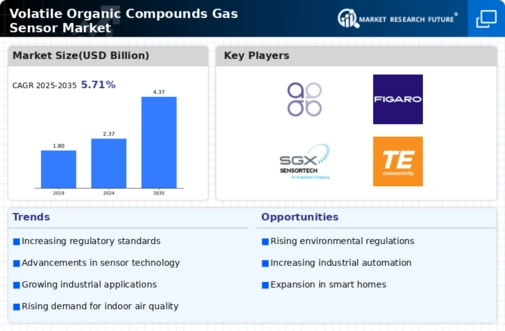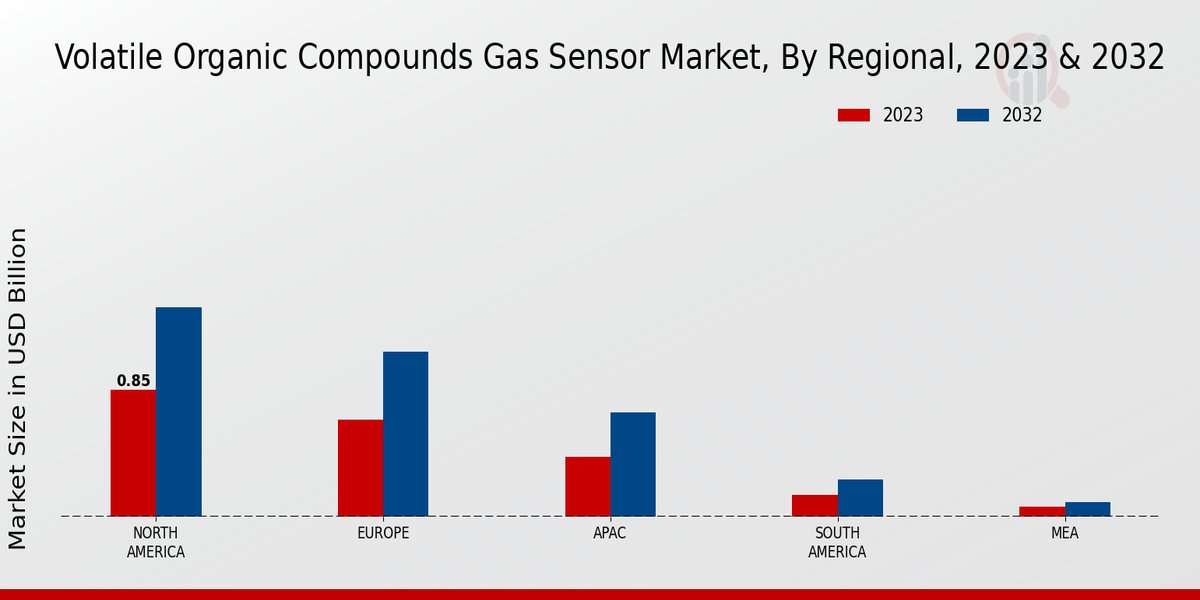Market Trends and Projections
Growth in Smart Home Technologies
The rise of smart home technologies is contributing to the growth of the Global Volatile Organic Compounds Gas Sensor Market Industry. As consumers increasingly adopt smart home devices, the integration of VOC sensors into these systems is becoming more prevalent. Smart home systems that monitor air quality can provide users with real-time data and alerts regarding VOC levels, enhancing overall indoor air quality. This trend is likely to drive demand for VOC sensors, as homeowners prioritize health and safety. The convergence of smart technology and air quality monitoring is expected to bolster market growth, reflecting the evolving landscape of consumer preferences.
Expansion of Industrial Applications
The expansion of industrial applications is a significant driver for the Global Volatile Organic Compounds Gas Sensor Market Industry. Industries such as manufacturing, automotive, and pharmaceuticals are increasingly utilizing VOC sensors to monitor emissions and ensure compliance with environmental standards. For example, the automotive sector employs VOC sensors to detect harmful emissions during vehicle production. This trend is expected to continue as industries seek to enhance their sustainability practices and reduce their environmental footprint. The growing industrial demand for VOC sensors is likely to contribute to the market's growth trajectory, aligning with the projected increase in market value over the coming years.
Increasing Environmental Regulations
The Global Volatile Organic Compounds Gas Sensor Market Industry is experiencing growth due to stringent environmental regulations aimed at reducing air pollution. Governments worldwide are implementing laws that mandate the monitoring of VOC emissions from industrial processes and consumer products. For instance, the United States Environmental Protection Agency has established guidelines that require industries to utilize VOC sensors to comply with air quality standards. This regulatory pressure is expected to drive the market, as companies seek to adopt advanced gas sensors to ensure compliance and avoid penalties. As a result, the market is projected to reach 2.37 USD Billion in 2024, reflecting the increasing demand for effective monitoring solutions.
Rising Awareness of Indoor Air Quality
Growing awareness regarding indoor air quality is significantly influencing the Global Volatile Organic Compounds Gas Sensor Market Industry. Consumers and businesses alike are becoming more conscious of the health impacts associated with poor air quality, leading to an increased demand for VOC sensors in residential and commercial spaces. For example, organizations are investing in air quality monitoring systems to ensure safe environments for occupants. This trend is likely to accelerate the adoption of VOC gas sensors, as they provide real-time data on indoor air pollutants. The market is expected to grow steadily, with a projected value of 4.37 USD Billion by 2035, indicating a robust demand for these technologies.
Technological Advancements in Sensor Technology
Technological advancements are playing a crucial role in shaping the Global Volatile Organic Compounds Gas Sensor Market Industry. Innovations in sensor technology, such as the development of miniaturized sensors and enhanced sensitivity, are making VOC detection more efficient and cost-effective. For instance, the integration of IoT capabilities in gas sensors allows for remote monitoring and data analysis, which is increasingly appealing to industries looking to optimize their operations. These advancements are likely to drive market growth, as they enable more accurate and timely detection of VOCs. The anticipated compound annual growth rate of 5.71% from 2025 to 2035 underscores the potential for continued innovation in this sector.














